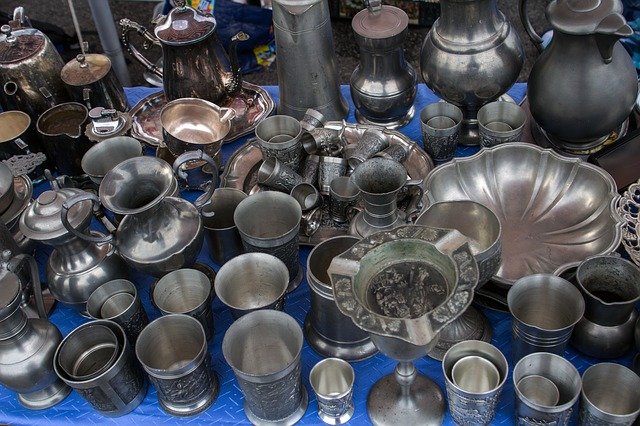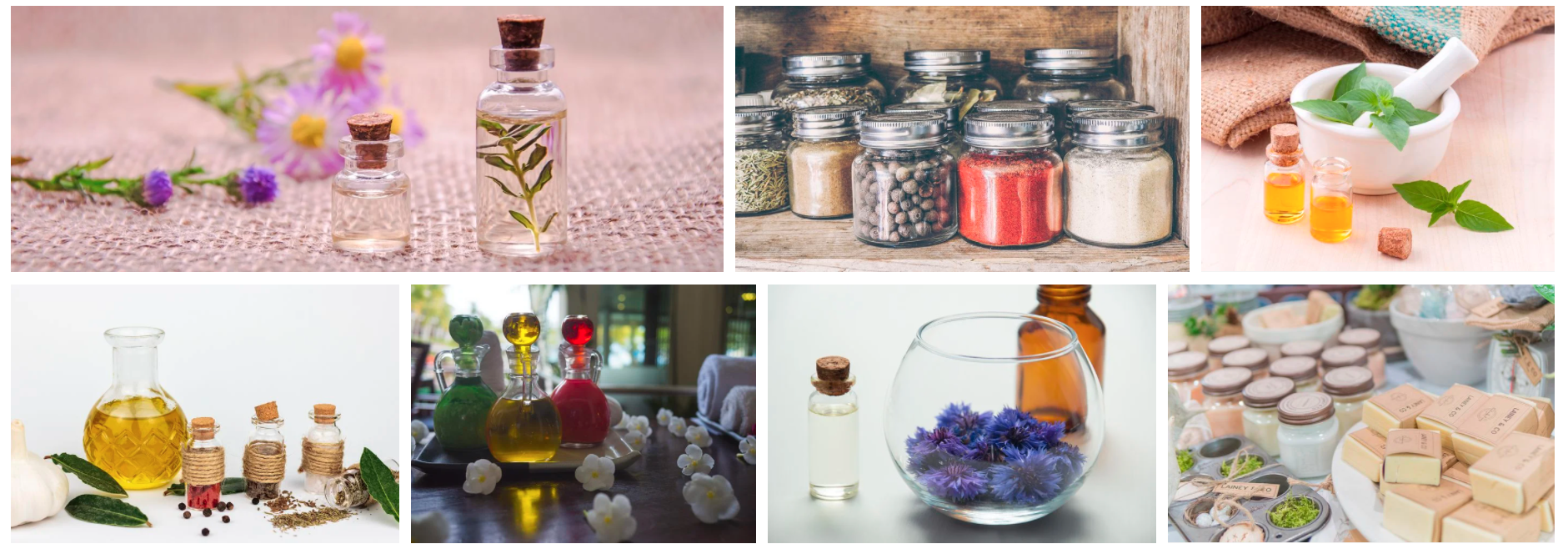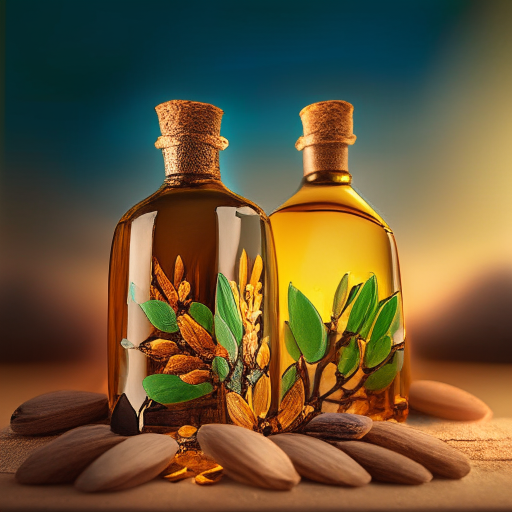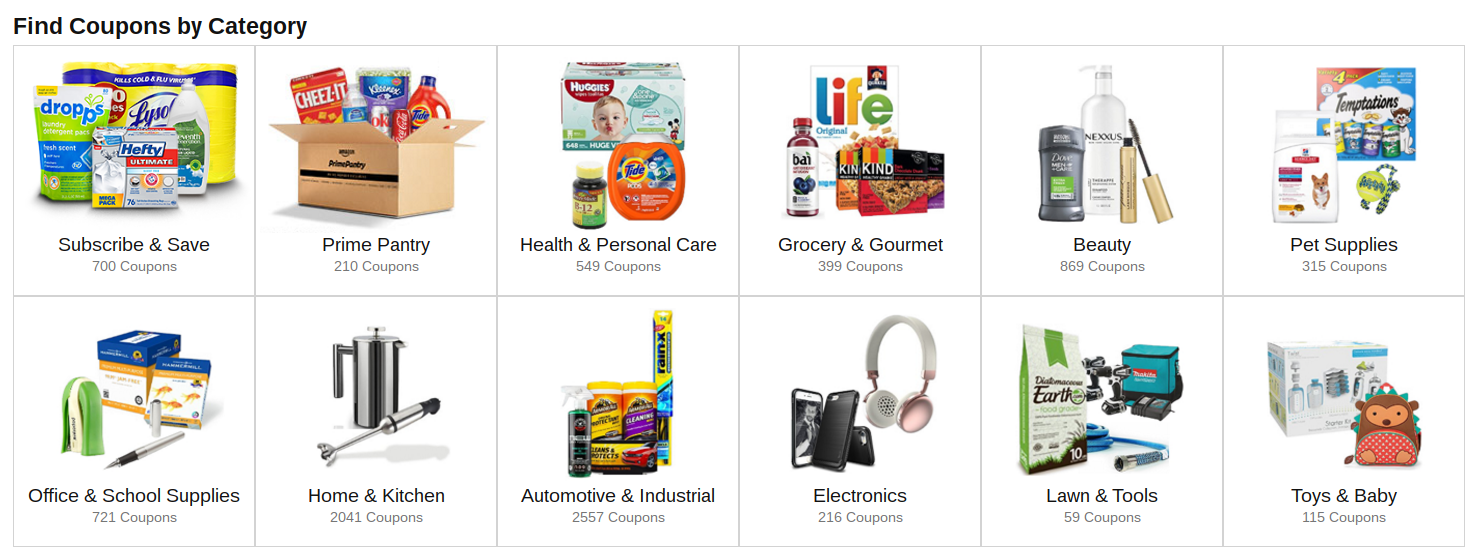- Home
- Hundreds of Home-made Household Recipes & Tips
- How To Clean Pewter Naturally
Guide on How to Clean Pewter Naturally Cheaply and Quickly, With Additional Tips on Identifying, Researching and Valuing Pewter Collectibles
Following are dozens of practical tips for how to clean Pewter naturally, cheaply and quickly using common non-toxic household ingredients.
There are specific cleaning and polishing tips for the 3 classes of Pewter (Polished Pewter, Satin Pewter and Oxidized Pewter) as well as a short video and tips for how to research and value older rarer Pewter collectibles lower down this page:
- Baking Soda + Oil : If pewter is stained or varnished, try putting baking soda on the stained or varnished area of pewter then gently rub the pewter with a cloth dipped in olive oil or vegetable oil. The pewter stain should disappear and a very thin layer of oil will lower oxygen exposure to the metal surface, thus helping to prevent future oxidation stains on your Pewter items.
- You can also make a paste of water and baking soda and use an old toothbrush to gently scrub the nookes and crannies of pewter pieces. Rinse and dry the items after polishing with baking soda. Repeat the process if needed. See below short video demonstrating this baking soda technique as well as using Ketchup as an effective pewter polish.
- Home-made Pewter Polish 1 : Lindseed Oil + Rottenstone : Carefully heat Linseed Oil and add to it Rottenstone (check your local hardware store). Mix the two until the mixture is thick yet smooth. Allow the Linseed Oil + Rottenstone mixture to cool and apply to Pewter item with small circular motions, polishing until your Pewter shines.
- Homemade Pewter Polish 2: Vinegar + Flour : For class of Pewter called "Polished Pewter", combine a cup of vinegar with one half cup of flour to make an effective home-made Pewter polish. Add a dash of salt for Satin Pewter polishing. Apply mixture to Pewter and allow to react for at least 20 minutes. Then rinse and wipe dry with cloth.
- How to Polish Pewter with Ketchup and Baking Soda: Watch the below short video showing how to clean pewter using Ketchup, which also contains vinegar and makes a great polish for Satin and Polished pewter.
- Home-made Pewter Polish 3: Ammonia + Soapy Water : To polish Pewter, dip a clean cotton cloth into a solution made by combining about a quart of hot soapy water with a few tablespoons of Ammonia. Polish gently. Wiping Pewter object dry when done.
- Satin Pewter should be polished sparingly, only every few years or so using super fine steel wool rubbed gently along the grain ... NOT in circular motions so as to minimize excessive scratching.
- Oxidized Pewter is a type of Pewter often intended to have a darker patina. Removing this darker Pewter patina will often reduce the piece's value. So if you know you have an Oxidized Pewter piece, NEVER polish it. But you can clean dirt from Oxidized Pewter with a mixture of warm water and dishwashing liquid. Drying thoroughly after cleaning.
- Boiled Eggs : After you make a large pot of boiled eggs, save the cooled water and soak your pewter items in it for at least 15 minutes. Rinse then gently rub with a dry cloth to remove pewter stains.
- Cabbage : The outer leaves of cabbage make great pewter polishers. Rub the pewter item with cabbage leaves, then further buff the pewter with a dry cloth.
- For tougher Pewter tarnish or stains you can safely scrub pewter with super-fine # 0000 steel wool dipped in Olive Oil. Once tarnish is gone, wash with soap and water and dry with cloth. Satin Pewter should only be buffed once every few years and only buff in strokes along the grain, NOT in circular motions.
- Soap + Water : To remove dirt from Pewter, simply wash the Pewter item with a mild soapy warm water mixture, then buff dry with a clean cloth.
- Diluted dish-washing liquid with hot water also works great for polishing all classes of Pewter items, satin pewter, polished pewter and oxidized pewter. Dry items well after cleaning.
- An old soft bristle toothbrush is great for getting in nooks and crannies of Pewter figurines while cleaning with soapy water.
- Beware of using harsh cleaning chemicals or abrasive cleansers on Pewter because it may cause permanent damage such as scratches or chemical reactions with the metal ions.
- To remove stubborn candle wax from Pewter Candelabras , place the Candelabras into a freezer until the wax is frozen and brittle, making it very easy to remove from your Pewter
- NEVER clean Pewter in an automatic dishwasher because Pewter's low melting point of 338–446 ° F (170–230 ° C) makes it vulnerable to damage during the hot cycles of a dishwasher.
Video: How to Clean Pewter Using Ketchup or a Baking Soda Paste
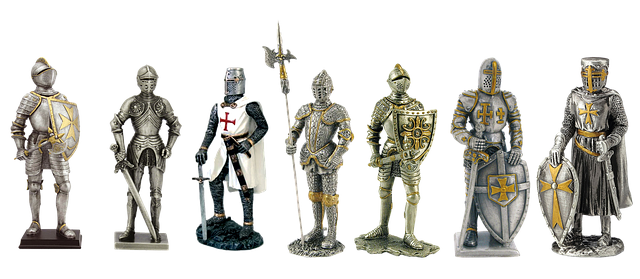 Follow the Above tips for Naturally Cleaning Antique Pewter Figurines Such as These Detailed Knights in Armor from the Middle Ages
Follow the Above tips for Naturally Cleaning Antique Pewter Figurines Such as These Detailed Knights in Armor from the Middle AgesWhat is Pewter Made Of and Why Does Pewter Need Cleaning?
Pewter is a soft metal alloy of tin (85–99%), antimony (approx. 5–10%), copper (2%), bismuth, and sometimes a little silver. Pewter is soft like lead and thus can be easily scratched or bent.
Copper and antimony are added in as hardeners, though Pewter is relatively soft and malleable nevertheless.
The metal atoms at the surface of Pewter alloys can react with Oxygen gas in the air to form metal oxides which will add a dull patina to Pewter items over time.
The above polishing tips will help gently remove dirt and oxides, thus rejuvinating your Pewter's appearance, but without damaging intended aesthetic or value.
Antique and Vintage Pewter Collectibles Can Be Quite Valuable, Here's How to Estimate Value of Pewter Antiques
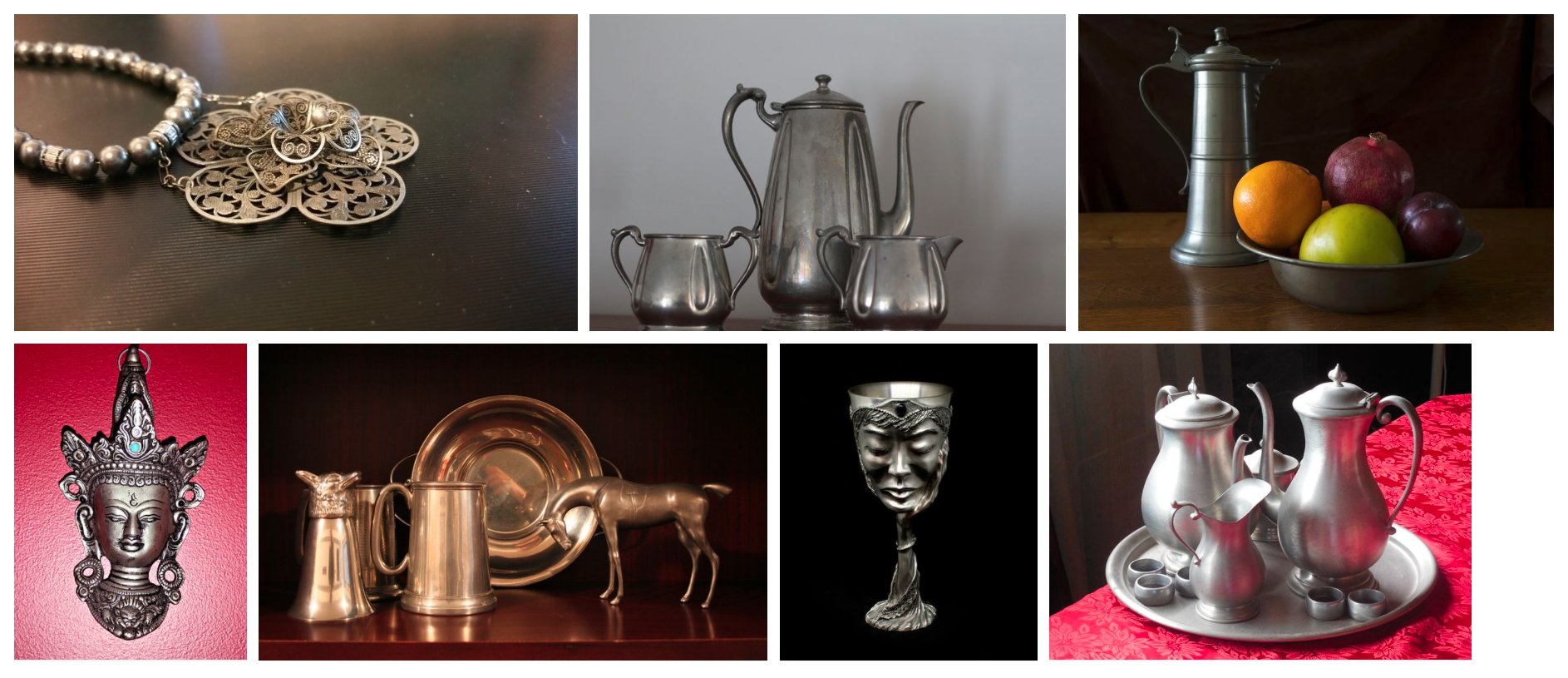 Following is an easy guide on how to quickly get an idea about value of pewter items, such as these antique pewter pitchers, cups, creamer, teapot, jewelry, ornaments, and horse
Following is an easy guide on how to quickly get an idea about value of pewter items, such as these antique pewter pitchers, cups, creamer, teapot, jewelry, ornaments, and horseThere is a healthy market for old pewter items. Thousands of pewter collectors are willing to pay big bucks for rarer pewter items.
Antique and vintage pewter items such as old pewter pots, pewter tankards, pewter figurines, and pewter kitchenware can be worth hundreds or thousands of dollars.
This is why it's so important to follow the above tips for how to clean pewter properly so as not to damage and devalue older and possibily more valuable pewter items.
As with old coins, physically or chemically scrubbing away the aged patina of an Oxidized antique pewter item can greatly devalue the piece.
Incidentally, if you have SCRAP PEWTER and just want to know how much you can expect to get in pewter scrap value, then look up the current price of Tin metal and divide it by half. That is roughly how pewter scrap price is calculated. Currently scrap pewter may earn you around $3 to $5 per pound. But always call your local scrap yard for up to date price of pewter scrap.
To research the value of your more collectible pewter items, check the piece for maker's marks, artist name, exchange hallmarks, labels, catalog numbers, capacity markings, quality markings or touch marks (thumb, fingerprint or initials) which are often found on the bottom of the piece or elsewhere.
Here is an excellent resource on Pewterer's marks and pewter makers by the Pewter Society
On older pewter drinking vessels, capacity markings showing how much a cup or tankard will hold is often a clue the vessel may be as old as the mid to late 1800's.
But keep in mind some of the most valuable older pewter antique items sometimes have no markings at all. For example, British and Irish pewter items were often unmarked.
How to Estimate Value of Pewter Collectibles Via Comparable Prices on Ebay Sold Listings
You can compare any markings and your style of pewter item to items that have already been sold on Ebay in order to get a rough idea of possible historical provenance and value range.
Into your browser's address bar type in Ebay.com and enter, or click here to be taken directly to Ebay's current antique pewter listings .
Note:
The following instructions are based on the device I use most when researching items at Ebay...my laptop or Chromebook. If you try to apply these tips using a mobile device, then Ebay's mobile app may require you to find the described menus and options within the mobile version.
At Ebay type into the search box at the top of the page a detailed description of the pewter item you are trying to value.
For example:
- "1970's Gucci Italy Pewter Quail Salt & Pepper Shakers" ... or ...
- "Barrett-Smythe Pewter Emblem Tyrannosaurus T-Rex Dinosaur ZIPPO Lighter MINT '93" ... or ...
- "Royal Selangor Hand Finished Splendour Collection Pewter" ... or ...
- "Large Antique Pewter Lidded Stein Tankard With Footed Base No Marking" ... or ...
- "Antique 19th c. Chinese Pewter Brass Temple Figurine Censor Base"
Then click the "Search" button.
This will bring up a list of currently listed for-sale items which are hopefully similar to your's. You can research similar listed items to learn more about your pewter item's possible history and specifics. But NEVER base value of pewter collectibles on current listing ask prices because anyone can ask anything for an item. But that does not mean it will sell for that!
It's no surprise the listing prices asked for are often elevated relative to the prices the items ultimately sell for.
So ... you want to consider what antique pewter items actually SOLD for to assertain a more realistic possible value based on what people were willing to recently pay for pewter items similar to your's.
Here's how you convert this list of currently for-sale pewter items with sellers' asking prices, into a list of already sold pewter items showing what bid price sellers actually accepted from interested pewter buyers ...
Scroll down the page. On the lower left margin of the Ebay search results page below all the other refine search options, click "More Filters" => in the popup option box click "Show Only" => check off "Completed items" and "Sold items" boxes => click the "Apply" button at the bottom right of popup box. This will convert the pewter for-sale list, into a list of sold pewter items with many items that are hopefully very similar or identical to your item (s) of interest.
Tip: I recommend you convert the list into "gallery view" to see more items per page. Click the small list icon at upper right of the list. Chose "gallery view".
Click on the listings showing pewter items identical or very similar to the items you are trying to value. Read the listing descriptions for more possible details about your item and view the images to see if maker's marks match your item. The more details you have about your pewter object, the better you can refine your solds search for closer matches.
Valuation Tip 1: As an experienced Ebay seller of vintage and antique items, in my experience I find Ebay sold prices are often discounted from sales prices at other online platforms and markets.
So it's possible any valuation you arrive at based on Ebay solds may in fact be a low ball base estimate valuation for any particular item. Your pewter may be worth more than what similar items previously sold for on Ebay, depending on how / where you ultimately might sell the item.
The benefit of Ebay is scope, it is by far one of the largest and most visited online reselling platforms.
Valuation Tip 2: If any sold item listings on Ebay show the number of "bids" below the sold price, this mean the item was sold using Ebay's auction method rather than a fixed price "buy it now" style listing. I've noticed that often the items sold on Ebay via the auction method frequently sell for significantly less than actual value. So I'd recommend ignoring most of the auction sold items when trying to determine value.
I'm often astonished how frequently valuable items are auctioned off for only 99 cents at Ebay because that was the only bid the seller got, and they for whatever reason didn't place a minimum reserve price on the item auction. If you know how to work the auctions and snipe items as the only bidder, you can score some great deals on Ebay.
But where valuation is concerned, these low ball auction solds might skew perceived estimated market valuations if you consider these anomolies in any consideration of item value. So statistically speaking, throw out these statistical outliers when looking for comparable sales.
Valuation Tip 3: The above tips for finding out how much older or rarer pewter collectibles may be worth are also valid for estimating value of ANY other items (old or new). If it sells, chances are you will find a sales history of the item on Ebay. Use these tips so you do not pay too much for something, or sell something too low.
Types and Classes of Pewter
- "Polished Pewter" is the most shiny, smooth and reflective class of Pewter. See above "homemade pewter polish 1 & 2" or Dishwashing Liquid + Hot Water or Ketchup or Baking Soda Paste tips for 5 suggestions on how to polish polished pewter gently and naturally (see above short video showing how to easily polish pewter using ketchup or baking soda paste).
- "Satin Pewter" is more grainy and less shiny than polished pewter. See above "home-made pewter polish 2" or Dishwashing Liquid + Hot Water recipe or Ketchup or Baking Soda paste tips on how to polish satin pewter gently and naturally (see above short video on how to quickly polish pewter using ketchup or baking soda paste ).
- "Oxidized Pewter" is often intended to have a darker oxide surface layer to give the aesthetic of an older or antique pewter piece. How to polish Oxidized Pewter? Answer: Oxidized Pewter should NEVER be polished because polishing may remove the intended oxide patina, thus changing the aged appearance and devaluing item. You can however clean Oxidized Pewter following the above tip for using a Dishwasher Liquide + Hot Water cleaning solution.
- "European Casting Alloy" consists of 94% tin, 5% antimony, and 1% copper.
- "European Pewter Sheet" consists of 92% tin, 2% copper, and 6% antimony.
- "Asian Pewter" (from Malaysia, Singapore, and Thailand) consists of 97.5% tin, 1% copper, and 1.5% antimony ... which makes it softer than most pewters.
- If you see the term "Mexican Pewter", it usually indicates an alloy of aluminum used to make decorative items.
Does Pewter Contain Lead?
The older the Pewter item, the more likely a higher Lead content may be. Antiquity Pewter consisted of tin alloyed with Lead and at times Copper. Lead was added to antique Pewter alloys to also impart hardness, though lower quality modern Pewter items may also contain higher Lead levels. Heavier Pewter that seems to tarnish faster and having a bluish tint or dark silver-grayish tint may have a higher Lead content. Pewter items with more of a bronze appearance may have a lower lead content. But it's safest to assume all pewter may contain lead.
Since Lead is a toxic metal, particularly to children, beware of Lead poisoning from older or poorer quality Pewter or Pewter with a bluish patina.
Keep Pewter away from children to be safe and do not consume food or drink from any object suspected to have elevated levels of Lead. Avoid inhaling or contaminating areas with fine particles of dust shed from Lead containing items, for example while polishing or buffing Pewter. And wash hands thoroughly after handling Leaded Pewter, and / or limit contact with skin.
Lead-free Pewter is common in newer pieces, but some newer Pewter items are still manufactured with higher Lead levels.
 Share Your Tips for How to Clean Pewter Naturally, Such as These Gorgeous Detailed Pewter Goblets of Elfin Women Wearing Crowns
Share Your Tips for How to Clean Pewter Naturally, Such as These Gorgeous Detailed Pewter Goblets of Elfin Women Wearing CrownsIf the Above Tips for How to Clean Pewter Naturally Are Not Enough, Then You May Want to Try One of These Top Selling Pewter Polish or Metal Polish Products ...
Tip: Read product details and product reviews carefully to be sure any metal polishing compound is safe for the specific use as a polish for your pewter items.
Some harsh chemicals and abrasives, such as in Bar Keepers Friend, may damage your pewter items and are NOT recommended for polishing pewter.
And for the class of pewter known as Oxidized Pewter, it is recommend that you NEVER polish it. Follow the above specific pewter cleaning tips instead.
Have Any of Your Own Tips for How to Polish Pewter Naturally Quickly and Cheaply? Add Your Tips In Comments Section Below ...
- Home
- Hundreds of Home-made Household Recipes & Tips
- How To Clean Pewter Naturally
Recent Frugal Living Articles
-
Hundreds of Easy Homemade Household Products Recipes for Frugal Living
Extensive list of simple home-made, non-toxic, and more effective product recipes you can quickly make yourself. Safer cheaper than toxic store-bought items -
Almond Oil Uses, Sources, Costs, Household Tips & Remedies
Guide to Almond oil, sources, current price per volume, ways to save money on almond oil, how to make it at home, and some common household remedy recipes -
40 Cheap Beef Cuts for Frugal Meals and Thrifty Beef Dishes
An extensive guide to the best cheap beef cuts with often more flavor and as much nutrients as prime loin cuts, yet without the tenderloin prices -
Hundreds of Senior Discounts for Frugal Retirees and Citizens Age 50 or Older
Extensive lists of Senior Discounts for hotels, cruises, restaurants, stores, travel deals, and much more -
New Amazon Coupon Codes: Uncensored & Avant Garde Tricks of the Trade
Become a Fiscal Zen Master of finding & maximizing Amazon Coupon Codes and deals. Learn from the Yoda of Online Gorilla Shopping Tactics & become a Thrifty Nemesis to Bean Counters & Billionaires
